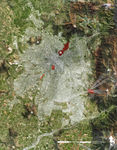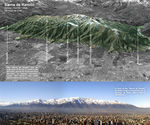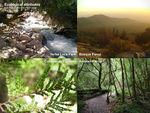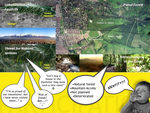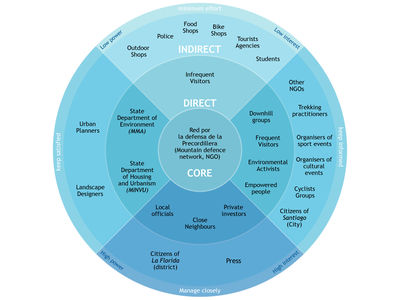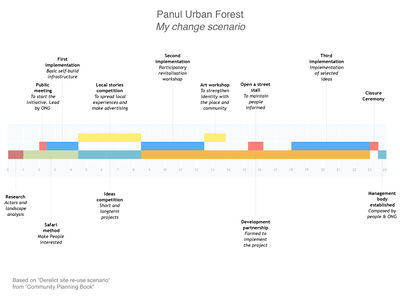Landscape Democracy 2015 Working Group C - Case Study 4
---> back to group page working group C
Urbanization over the foothills: The case of the Panul Forest in Santiago de Chile
| Place name | Panul Urban Forest | |
| Location | Santiago | |
| Country | Chile | |
| Author(s) | Christian Soria | |
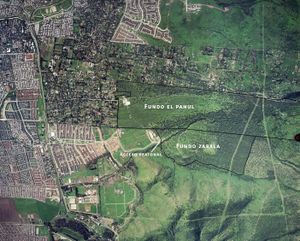
| ||
|
| ||
Rationale: Why have you chosen this case for the landscape and democracy seminar?
Due to the constant growth of Santiago de Chile's city over the foothills of the Andean mountains through the development of big extensions of middle-high class residential projects without a proper participation of inhabitants during the planning and design process, it is important to rethink the way this natural places are being integrated to the urban structure and to the life of the surrounding inhabitants, considering the big potential of this area as a place to complement the citizens experience and where to develop identity, also as a rich environment with important ecological functions and realize the potential risks that may affect the population because of this natural processes. Because of this, the implementation of a multidisciplinary participatory design process in the planning of El Bosque Panul Forest may improve the relation between city’s outskirts and natural areas as transitional points where to strength arrangement and integration with the environment at a physical but also social and ecological level.
Representation of your observations
- you are basically free to use one or a mix of different presentation techniques
- possibilities are: analytical drawings, graphical representations, collages, video clips, comic/graphic novel, written essay/visual essay
- please add any visual material to the gallery, videos can be placed below, you may add text as you like
- Observations
Reflection
What are the major challenges for changing the situation?
Some of the major challenges involved are the revaluation of the strategies and regulatory policies used in terms of urban growth over natural-rural areas (El Bosque Panul Forest in this case), in order to reconsider the environmental development model as a complex concept that integrates the participation of experts and the public and private sector on its creation and management through the analysis, the participation and the strengthening of governmental policies and tools. This process may involve several challenges at a metropolitan scale, with a long term process and with many necessary changes at a political, economic and social level, what would take a long time.
A more local intervention also can be made, starting with a specific case like Panul Forest and with a more manageable number of citizens, focusing on the improvement of identity and awareness with the environment (mountains) to initiate a social change that later can grow and spread to the rest of population. With local resources and with no big political changes, a participatory design process can be addressed to promote the change to a more integrated environment.
In both cases, at metropolitan or local level interventions the major challenge is to attract people, make them participate and finally reach a real growth on their awareness.
What could be a starting point for democractically-based change?
For this case, a good starting point is to identify the main actors involved directly or indirectly but also the analysis of the landscape and territory. Know their needs, potentials, weaknesses, threats and strengths may let us create a good strategy to attract them, make them feel comfortable, get their confidence and then start a democratically participatory process that would lead to a democratic change.
Because we are talking of a natural forest directly connected to the city, and because there is evidence of a lack of identity and arrangement with this area, during the different stages of the participatory design process a parallel program of activities within the forest has to be developed, this with the intention of promote by direct contact the social and environmental change. Safari trips, concerts, agriculture workshops and many others activities can be very useful to engage the community with the natural heritage, but also to integrate themselves as society.
Stakeholder Mapping
The visual representation of the actors has been made through a combination of the “Onion model” and a graphic that shows the power and interest of them in the issue. By that we can quickly realize the order we have to follow to maintain a good communication and how we have to manage it, through monitoring, constant information channels, through major interventions or all of them.
- Stakeholder Map
Change Scenario
The change scenario takes as a basis the “Derelict site re-use scenario” with some modifications that respond to the particular study case. Considering the conditions of deterioration and abandonment that some areas of the park present, and also the lack of a master plan or strategy to manage the forest, the “Derelict site re-use scenario” presents some characteristics and a compatible focus with the actual scenario in the Panul Forest, stablishing a process of 2 years where people can participate be informed but also participate on the decisions in different instances, by ideas competencies, art workshops, or self-build implementation phases.
The complementation or contextualization of the basis program add more activities “in situ” with the involvement of the people, this because the empowerment and social awareness are as important as the planning and environmental revitalization of the forest.
- Change Scenario
Cross cutting theme
Despite the study cases have a different location (inner city and city outskirts) and a different timeframe process, they have in common that both pursuit an improvement of quality of life through the creation of a better environment with an active participation of the involved citizenship. The strategies to reach a “democratic landscape” state is mainly based on the action of inhabitants and professionals (and or experts) in direct contact with the space, as a way to generate a quick response to the identified problems, as well as to empower the people and create identity and awareness to maintain a continuity in the process of landscape improvement. The goal is not just to correct the initial identified problem (or problems), but also to develop a cultural change perdurable in time. For this, both strategies realise that a close and wise coordination of the different actors must be carefully done, with constant debates and dynamic information channels to maintain a feed back between people, coordinators and results.
Concluding reflections
I believe that the proposed change model could have a big potential if it is implemented with a clear and correct lecture of the people, and with a careful management of confidence. Confidence and attractive activities will drive people in a constructive and positive direction, but this takes time and effort that need to be maintained in order to create a deep root into the culture of society.
Because this case is based on a natural place many outdoor activities can be made, which is a big advantage in order to engage people through experiences. To this, the change model tries to force them with continuity and different activities or instances using several channels, by walking, writing a story, planting a tree or by self-build workshops to build necessary infrastructure within the park.
Nevertheless, to really enroot this knowledge, idea or spirit into people, a long time process is needed until they by themselves were able to continue this never ending relation between environment and us.
References
* Please make sure that you give proper references of all external resources used.
* Do not use images of which you do not hold the copyright.
* Please add internet links to other resources if necessary.
About categories: You can add more categories with this tag: "", add your categories
